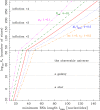Emergence of life in an inflationary universe
- PMID: 32015390
- PMCID: PMC6997386
- DOI: 10.1038/s41598-020-58060-0
Emergence of life in an inflationary universe
Abstract
Abiotic emergence of ordered information stored in the form of RNA is an important unresolved problem concerning the origin of life. A polymer longer than 40-100 nucleotides is necessary to expect a self-replicating activity, but the formation of such a long polymer having a correct nucleotide sequence by random reactions seems statistically unlikely. However, our universe, created by a single inflation event, likely includes more than 10100 Sun-like stars. If life can emerge at least once in such a large volume, it is not in contradiction with our observations of life on Earth, even if the expected number of abiogenesis events is negligibly small within the observable universe that contains only 1022 stars. Here, a quantitative relation is derived between the minimum RNA length lmin required to be the first biological polymer, and the universe size necessary to expect the formation of such a long and active RNA by randomly adding monomers. It is then shown that an active RNA can indeed be produced somewhere in an inflationary universe, giving a solution to the abiotic polymerization problem. On the other hand, lmin must be shorter than ~20 nucleotides for the abiogenesis probability close to unity on a terrestrial planet, but a self-replicating activity is not expected for such a short RNA. Therefore, if extraterrestrial organisms of a different origin from those on Earth are discovered in the future, it would imply an unknown mechanism at work to polymerize nucleotides much faster than random statistical processes.
Conflict of interest statement
The author declares no competing interests.
Figures

Similar articles
-
M stars as targets for terrestrial exoplanet searches and biosignature detection.Astrobiology. 2007 Feb;7(1):85-166. doi: 10.1089/ast.2006.0125. Astrobiology. 2007. PMID: 17407405 Review.
-
Habitable zones around main sequence stars.Icarus. 1993 Jan;101(1):108-28. doi: 10.1006/icar.1993.1010. Icarus. 1993. PMID: 11536936
-
Chemical studies on the existence of extraterrestrial life.J Br Interplanet Soc. 1992;45:241-9. J Br Interplanet Soc. 1992. PMID: 11537802 Review.
-
The Emergence of Astrobiology: A Topic-Modeling Perspective.Astrobiology. 2023 May;23(5):496-512. doi: 10.1089/ast.2022.0122. Epub 2023 Feb 24. Astrobiology. 2023. PMID: 36827584
-
Bayesian analysis of the astrobiological implications of life's early emergence on Earth.Proc Natl Acad Sci U S A. 2012 Jan 10;109(2):395-400. doi: 10.1073/pnas.1111694108. Epub 2011 Dec 22. Proc Natl Acad Sci U S A. 2012. PMID: 22198766 Free PMC article.
Cited by
-
RNA World Modeling: A Comparison of Two Complementary Approaches.Entropy (Basel). 2022 Apr 11;24(4):536. doi: 10.3390/e24040536. Entropy (Basel). 2022. PMID: 35455198 Free PMC article.
-
Prebiotic Aggregates (Tissues) Emerging from Reaction-Diffusion: Formation Time, Configuration Entropy and Optimal Spatial Dimension.Entropy (Basel). 2022 Jan 14;24(1):124. doi: 10.3390/e24010124. Entropy (Basel). 2022. PMID: 35052150 Free PMC article.
-
Estimating survival probability using the terrestrial extinction history for the search for extraterrestrial life.Sci Rep. 2020 Jul 30;10(1):12795. doi: 10.1038/s41598-020-69724-2. Sci Rep. 2020. PMID: 32733049 Free PMC article.
References
-
- Kitadai Norio, Maruyama Shigenori. Origins of building blocks of life: A review. Geoscience Frontiers. 2018;9(4):1117–1153. doi: 10.1016/j.gsf.2017.07.007. - DOI
-
- Yamagishi, A., Kakegawa, T. & Usui, T. (eds.) Astrobiology: From the Origins of Life to the Search for Extraterrestrial Intelligence (Springer, 2019).
Publication types
MeSH terms
Substances
LinkOut - more resources
Full Text Sources

